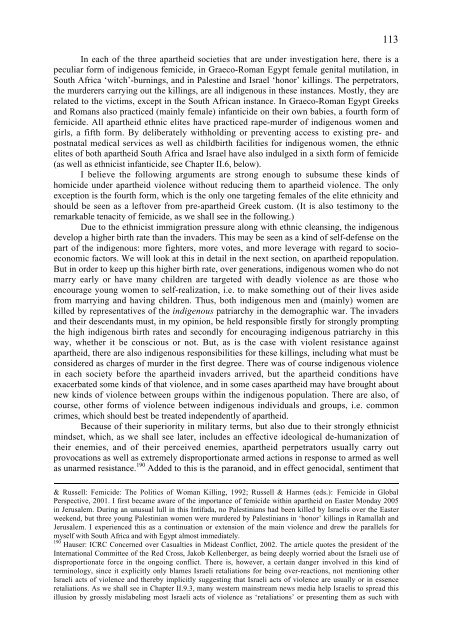Apartheid
Apartheid
Apartheid
You also want an ePaper? Increase the reach of your titles
YUMPU automatically turns print PDFs into web optimized ePapers that Google loves.
113<br />
In each of the three apartheid societies that are under investigation here, there is a<br />
peculiar form of indigenous femicide, in Graeco-Roman Egypt female genital mutilation, in<br />
South Africa ‘witch’-burnings, and in Palestine and Israel ‘honor’ killings. The perpetrators,<br />
the murderers carrying out the killings, are all indigenous in these instances. Mostly, they are<br />
related to the victims, except in the South African instance. In Graeco-Roman Egypt Greeks<br />
and Romans also practiced (mainly female) infanticide on their own babies, a fourth form of<br />
femicide. All apartheid ethnic elites have practiced rape-murder of indigenous women and<br />
girls, a fifth form. By deliberately withholding or preventing access to existing pre- and<br />
postnatal medical services as well as childbirth facilities for indigenous women, the ethnic<br />
elites of both apartheid South Africa and Israel have also indulged in a sixth form of femicide<br />
(as well as ethnicist infanticide, see Chapter II.6, below).<br />
I believe the following arguments are strong enough to subsume these kinds of<br />
homicide under apartheid violence without reducing them to apartheid violence. The only<br />
exception is the fourth form, which is the only one targeting females of the elite ethnicity and<br />
should be seen as a leftover from pre-apartheid Greek custom. (It is also testimony to the<br />
remarkable tenacity of femicide, as we shall see in the following.)<br />
Due to the ethnicist immigration pressure along with ethnic cleansing, the indigenous<br />
develop a higher birth rate than the invaders. This may be seen as a kind of self-defense on the<br />
part of the indigenous: more fighters, more votes, and more leverage with regard to socioeconomic<br />
factors. We will look at this in detail in the next section, on apartheid repopulation.<br />
But in order to keep up this higher birth rate, over generations, indigenous women who do not<br />
marry early or have many children are targeted with deadly violence as are those who<br />
encourage young women to self-realization, i.e. to make something out of their lives aside<br />
from marrying and having children. Thus, both indigenous men and (mainly) women are<br />
killed by representatives of the indigenous patriarchy in the demographic war. The invaders<br />
and their descendants must, in my opinion, be held responsible firstly for strongly prompting<br />
the high indigenous birth rates and secondly for encouraging indigenous patriarchy in this<br />
way, whether it be conscious or not. But, as is the case with violent resistance against<br />
apartheid, there are also indigenous responsibilities for these killings, including what must be<br />
considered as charges of murder in the first degree. There was of course indigenous violence<br />
in each society before the apartheid invaders arrived, but the apartheid conditions have<br />
exacerbated some kinds of that violence, and in some cases apartheid may have brought about<br />
new kinds of violence between groups within the indigenous population. There are also, of<br />
course, other forms of violence between indigenous individuals and groups, i.e. common<br />
crimes, which should best be treated independently of apartheid.<br />
Because of their superiority in military terms, but also due to their strongly ethnicist<br />
mindset, which, as we shall see later, includes an effective ideological de-humanization of<br />
their enemies, and of their perceived enemies, apartheid perpetrators usually carry out<br />
provocations as well as extremely disproportionate armed actions in response to armed as well<br />
as unarmed resistance. 190 Added to this is the paranoid, and in effect genocidal, sentiment that<br />
& Russell: Femicide: The Politics of Woman Killing, 1992; Russell & Harmes (eds.): Femicide in Global<br />
Perspective, 2001. I first became aware of the importance of femicide within apartheid on Easter Monday 2005<br />
in Jerusalem. During an unusual lull in this Intifada, no Palestinians had been killed by Israelis over the Easter<br />
weekend, but three young Palestinian women were murdered by Palestinians in ‘honor’ killings in Ramallah and<br />
Jerusalem. I experienced this as a continuation or extension of the main violence and drew the parallels for<br />
myself with South Africa and with Egypt almost immediately.<br />
190 Hauser: ICRC Concerned over Casualties in Mideast Conflict, 2002. The article quotes the president of the<br />
International Committee of the Red Cross, Jakob Kellenberger, as being deeply worried about the Israeli use of<br />
disproportionate force in the ongoing conflict. There is, however, a certain danger involved in this kind of<br />
terminology, since it explicitly only blames Israeli retaliations for being over-reactions, not mentioning other<br />
Israeli acts of violence and thereby implicitly suggesting that Israeli acts of violence are usually or in essence<br />
retaliations. As we shall see in Chapter II.9.3, many western mainstream news media help Israelis to spread this<br />
illusion by grossly mislabeling most Israeli acts of violence as ‘retaliations’ or presenting them as such with

















